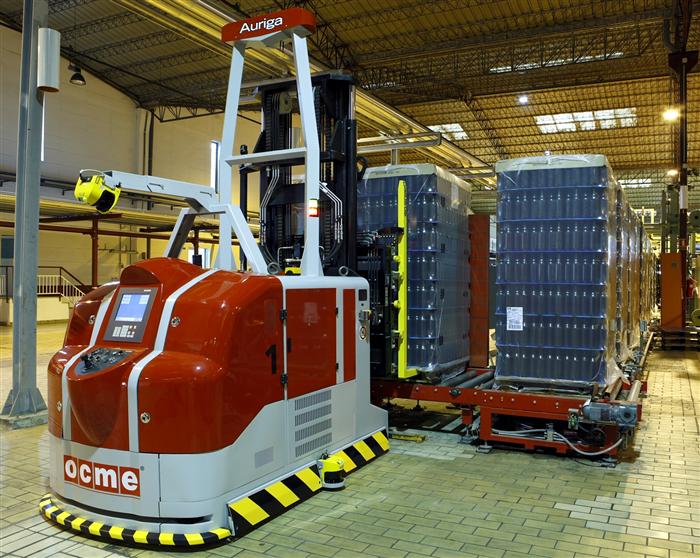It’s been more than 60 years since the first Automated Guided Vehicles (AGVs) began moving product through warehouses, and the technology is still going strong. Research and Markets reports “the automated guided vehicle market is expected to reach USD 2.68 billion by 2022, growing at a CAGR of 9.34% between 2017 and 2022.” Compared to Automated Storage and Retrieval Systems (ASRS), AGVs are not only more flexible and more easily scaled, but also involve a smaller capital expense and can be implemented in an existing warehouse with fewer structural modifications.
While AGV technology can reduce costs, increase safety, operate 24/7 and reduce damage, the road to automation nirvana can be a perilous. Here we’ll review some of the factors to consider when seeking to ease the transition from traditional warehouse logistics to a fully automated AGV system.
1. Pilot on a Small Scale
Like any major technology or process change, it’s a good idea to pilot the use of AGVs on small scale. Introduction of AGV technology in a limited area of the facility can help acclimate the team to the new system, highlight potential challenges before the system scales warehouse-wide and buildout infrastructure to reduce risk.
2. Consider Outside Costs
Integration of AGVs into a traditional warehouse setting can involve a number of potential costs beyond the AGV vendor’s purchase order. To prepare the site for its new robotic friends, one must consider things such as the costs of business & PLC systems integration, conveyor and system upgrades, an enhanced and extended design effort, structural repairs, and layout changes that may be required to make the facility AGV-ready.
3. Slow and Steady is the Only Race
AGVs provide fixed capacity and do not respond well to a choppy operation (without prohibitive cost). They will force upstream (manufacturing) and downstream (transportation) operations to improve—willingly or not. The daily influx of drivers dropping trailers before lunch will no longer be possible. You may need to evaluate adjacent operations to help smooth material flows and address causes of variability.
4. Know Your AGV Vendor
In the field of AGV technology, there are a lot of great companies and account representatives with skilled execution teams, but there are not so great ones as well. Since accuracy in design and installation are critical, make sure you know who will be delivering your system and the amount of time they will be spending on your project. While not all vendors will be able to provide this information early on, they should do so before you ink the deal.
5. Define Detailed Design Data and Assumptions
This is an obvious point, but it needs to be underscored. Simulated data must include all movements within the warehouse under AGV control, including:
- Daily, weekly and monthly inbound and outbound volumes
- Raw material movements to production
- Internal movements such as housekeeping / consolidation, cycle counting, quality inspections, etc.
- Accurate cross-docking percentages and other “alternate” product paths.
- Empty pallet stack replenishments, trash / broke container exchanges, corrugate, stretch wrap, etc.
Future volumes and AGVs should be planned for, each site has a saturation point and that is good to know up front.
6. Design and Approvals
AGV solutions operate in a semi-controlled environment; and are often very complex, time-consuming and labor intensive automation projects from a design perspective. Changes (gaps) often impact multiple teams, are slow to implement, expensive and can cause considerable pain to the operation until resolved. Future sites, business and operational considerations should be kept in mind to save heartache and money down the road.
All respective departments need a seat at the table for the entire meal, and need to provide final design and acceptance approvals. Once the final acceptance test (FAT) is signed, any leverage you have with the vendor is gone. The contractual payment schedule is another consideration, but that is a different topic.
7. Identify Super User Selection
Early identification of a Super User / lead is essential to attaining the most efficient implementation of an AGV System. This person is not only important in regards to learning the AGV system, but will function as a customer advocate by working with operations daily to help coordinate the necessary support and resources. This person must have a good understanding of the facility and systems, as well as an electrical/mechanical background. To assure optimal results, the technology needs to be embraced by the entire team.
8. Assign AGV Responders
Uptime is paramount to both operational success and realizing return on investment. A select group of individuals needs to be assigned the responsibility of ensuring seamless operation. Providing these individuals with pagers will allow them to respond immediately to any AGV alarms—a factor that is especially crucial in larger facilities.
9. Downtime Reporting
Downtime caused by operations (human intervention) and technical issues (system or mechanical) needs to be systemically captured, reported and mitigated. Vendors do not always like to provide this information, but it is possible, crucial to success and needs to be included in the contract.
There are a myriad of other considerations with an AGV project to reach steady state, and this list is just the beginning. Whether you are performing due diligence, the project is in-flight, in need of optimization or rescue; the right objective partner supporting your team can make all the difference.
Image Credit: OCME via Wikimedia
As of September 8, 2020, Crimson & Co (formerly The Progress Group/TPG) has rebranded as Argon & Co following the successful merger with Argon Consulting in April 2018.







